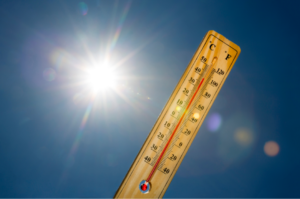 Did you know, in the first few days of working in warm or hot environments the body needs to build a tolerance to heat gradually over time?
Did you know, in the first few days of working in warm or hot environments the body needs to build a tolerance to heat gradually over time?
This process is known as heat acclimatization, and according to OSHA, 50-70 percent of outdoor fatalities occur in the first few days of working in warm or hot environments before the body has time to adjust. As part of National Safety Month, BCSP wants to remind you about the dangers of working in hot environments, or heat hazards.
Most work environments that are exposed to heat stress are ones you might already know: construction, agriculture, landscaping, delivery, oil and gas. However, there are indoor environments you may not recognize as hot environments. Some of these include bakeries, kitchens, laundries, fire service, iron and steel mills, and warehousing.
To prevent heat illness, OSHA recommends employers and employees remember three keywords: water, rest, and shade.
Water: Proper hydration is essential in the prevention of heat-related injuries. Employers should provide cool water for workers to drink. Employees working in heat should drink one cup (eight ounces) every 20 minutes, not just when they are thirsty. Workers lose salt and electrolytes in their sweat, so sports drinks or other electrolyte beverages are recommended for longer jobs (i.e., more than two hours).
Rest: Breaks are recommended in situations of heat stress. As the heat increases, so should the frequency and duration of breaks. The length of breaks depends on several factors, but OSHA has provided more information on their Heat Hazard Recognition page.
Shade: Workers should be given a cool location where they can take their breaks and recover from the heat. This might be a shady area outdoors, a building or tent, an air-conditioned car, or an area with fans and misting devices. Indoors, workers should be allowed to rest in a cool or air-conditioned area away from heat sources such as ovens and furnaces.
OSHA has great tools and information on their Heat Exposure page, including information on planning and supervision, heat-related illnesses, prevention methods, and other important resources.
Stay safe and cool out there!
